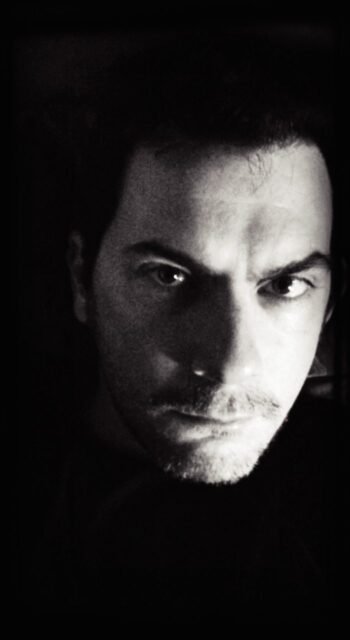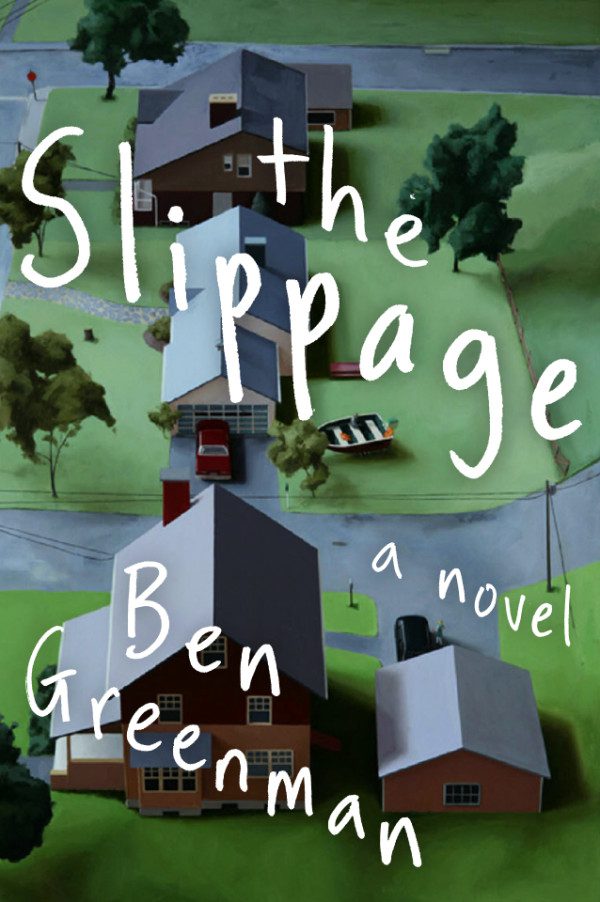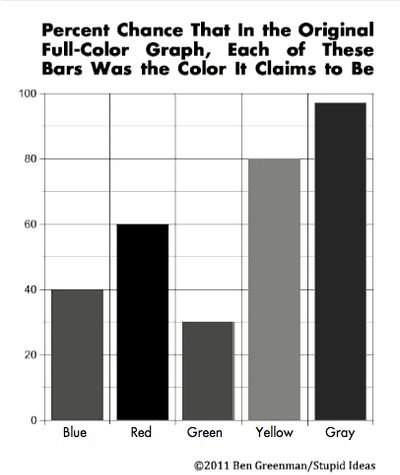
Ben Greenman’s new novel, The Slippage, features a visual artist who makes ironic, self-referential graphs and pie charts. “Charts about the way people look at charts,” he explains. His graph, “How You Will Understand This Graph Over Time,” displays a line that rises sharply and then drops off. One of his pie charts is entitled, “Is This Pretty Much the Roundest Thing You’ve Ever Seen?”
The chart artist also has a theory, about something he calls “the slippage.” The slippage, he explains to William, the principal character in the novel, is different from the slippery slope. “The slippery slope is for politicians and propagandists,” the chart artist says. “The slippage is a specific thing. It’s the moment when you start to lose your footing.”
Humor and experimental fiction—charting the meaning of charts, playing with ideas like a slippage between the gears of perception and reality—have been Ben Greenman’s stock in trade. He is the author of, among other works, a collection of partially-modernized Chekhov stories populated with celebrities, and a story collection originally issued by a specialty publisher as a series of postmarked letters. “Blurbs,” one of the pieces in Greenman’s experimental humor collection Superbad, consists of a series of blurbs that blurb the humor piece the blurbs comprise.
So readers may be surprised to learn that Tom, the chart artist in The Slippage, resides in an almost-traditional novel about the alienations and estrangements of a suburban marriage. Ben Greenman, prolific writer of experimental fiction, has written his own version of the Great American Novel.
The Slippage was released last week, and has received favorable early reviews in The Observer and The New York Times. Greenman and I conversed over Gchat the day before its publication.
***
The Rumpus: You have written a lot of meta-fiction, or what might be called experimental fiction. But it seems you have now written a more “traditional” novel. So I think the first question is, why the shift in form, if that’s a fair description?
Ben Greenman: Well, one of the things about writing experimentally (if that’s a fair description) is that repetition is difficult. Or rather: it’s easy but extremely unwelcome. Once you pull a rabbit out of a hat, it’s hard to pull another rabbit out of a hat, in the sense that the effect has just been performed. Even if you go through a number of narrative strategies, as I have, they still have similar rhythms and expectation-exploding powers.
And so I came to the notion of something “traditional.” The trap door of it, of course, is that I think it’s actually much less traditional, in some ways, than the others. I could be wrong—I was the one who thought that Please Step Back, a novel about a black funk star from the seventies, was my most autobiographical book. But I think that this has the veneer of a traditional novel with none of the innards of one.
Rumpus: In what ways might the novel be experimental within its so-called traditional or realist framework? There’s the chart artist, for example. He seems like one example.
 Greenman: That chart artist, Tom, was actually the genesis of it, so it started as a more traditional non-traditional. But as it moved away from him, into the more familiar (if not exactly recognizable) lives of William and Louisa, I wanted to think subversively not about form, but about the entire question of a traditional novel. What does it do? What is it supposed to do?
Greenman: That chart artist, Tom, was actually the genesis of it, so it started as a more traditional non-traditional. But as it moved away from him, into the more familiar (if not exactly recognizable) lives of William and Louisa, I wanted to think subversively not about form, but about the entire question of a traditional novel. What does it do? What is it supposed to do?
Some people would say that it is supposed to release realistic characters into a realistic setting, where realistic things happen to them and they come to some resolution. That’s about the most unrealistic, surreal, artificial thing in the world, though. Life is rarely like that. It’s full of unexpected repetitions and randomness and long stretches of uneventfulness and lack of affect. Circumstances and insights glint like broken glass in a field and you’re not really sure where the reflection is coming from.
So much of this novel, as it grew, took hold around my deep suspicion of things like traditional character and traditional setting and traditional plot, even as it was also participating in them to some degree.
I will also say that the novel is bound to the rise of the middle class. And so there’s a kind of historical inertia (and danger) involved in taking it at face value. But after having come at it with various weapons over the years, there’s also a kind of subversion that happens from within.
Rumpus: This novel doesn’t seem to always exhibit the line of rising and falling action we’re taught to look for in a story. It seems, instead, to present a series of credible, engaging scenes that dramatize the alienation and estrangement in William and Louisa’s marriage.
Greenman: To some degree that’s true. I mean, there are the outlines of a traditional plot. There are gestures that seem like they would be part of one: wife says X, husband resumes affair with Y. But beneath that there’s a kind of weird distancing from meaning, a denial of service. First of all, why would a man have an affair with a letter? That would hurt. I also thought about the idea of liking something (a life, a plot, a book), and it occurred to me very early on that it wasn’t important. Meaning this: the characters don’t really care about whether or not they like their lives. They’re in them.
That’s sort of what I wanted to happen, what I want to happen. Do readers like this book? Who cares? They’re in it. That probably needs a little elaboration. I’m human. I prefer praise to the other thing—the opposite of praise. But I also know that artworks of any kind need to grapple with that question: how pleasing should a surface be, and what happens if the wading pool looks beautiful and you step into it, only to have a sea snake put fangs in your foot? This is an idiotic metaphor to describe a more problematic process.
Rumpus: That idea comes through with power in the novel. Even the affair William has, and then resumes, does not really present the possibility of escape from the marriage. Instead it seems to offer a distraction within the marriage.
Greenman: When I first turned it in, my publisher responded strongly and not entirely positively to this idea: that the best you can hope for is to recognize the shape of the trap that you’re in. But I didn’t want to create an out. There is no out. There’s no out for the marriage and no out for the life.
Rumpus: Another example might lie in the juxtaposition between Tom’s idea of the slippage and the evolution of William and Louisa’s marriage. In a novel, you sort of expect to see some relationship there. I’m not sure I did.
Greenman: It’s interesting because some readers and reviewers see Tom as a pretty clear foil for William: they see his philosophy of the slippage—which hangs over or at least next to the main plot—as a kind of destination for William as he gets smarter and/or wiser. I think it’s interesting that they respond that way, and completely fine. But it’s not how I see it, necessarily. I see them as independent philosophies that sometimes accidentally overlap.
I also wanted a tension between what is a very programmatically generic suburb, down to the houses and the cars, and a much more dangerously disorganized and unregulated set of thoughts regarding marriage, commitment, identity, meaning, joy, compromise, and the passage of time.
Rumpus: Tom’s theory of the slippage is a way of describing how you can lose your footing in a situation. Your perspective shifts, and you see yourself in a different relationship to others and the world. What does that mean for William?
Greenman: Let me say what it means for me first. I live in a constant state of fury with regard to the way that facts are presented and organized for public consumption. Start there. And in a constant state of suspicion with regard to any and all knowledge. Tom shares that with me. Or maybe I shared it with him. As for William, well, he is at least initially a little more reluctant to embrace that philosophy, partly because he doesn’t style himself the way Tom does, and partly because he hasn’t experienced the same kind of jettisoning/clarifying pain as Tom. It’s a slower anti-morphine drip, William’s life. But I also wanted to think through the idea of truth itself not being available: not to a group of people (which is something we accept to some degree, because we know that groups distort via interpretation and referendum) but also maybe not to an individual.
Rumpus: It might have been unfaithful to the narrative to have it drive toward a revelation of meaning in William’s life. There may not be any meaning. If there is, William may not see it. William’s understanding of his situation is limited to his own condition, to the few things he can see.
Greenman: Yes. I think that’s true. To me the most realistic character was a character who saw only part of what was around him.
But there’s a risk in all of this, at least from the author perspective, which is that you’re writing something that doesn’t foreground the superficial pleasures that a reader may desire. I mean, it does at the level of the language (if I do say so my damned self), and there’s some nudity and sex. People like sex, both in the book and outside of it. What there isn’t is the kind of epiphany and transport that gets called “lesson” or “learning” or even release at the level of the main narrative. There’s a kind of shedding process instead: a taking away of certain kinds of consequence and certain types of energy. I wanted to put a big banner on the front that said “Without Imagination!” (I didn’t really want to.)
Rumpus: Maybe you can put that on the foreign language editions?
Greenman: Done! That’s the main difference between some of the other books and stories I have done, which work out these same issues via playfulness, and this one, which goes for the empty, wordless throat. It sounds exciting when I describe it that way: “The Empty, Wordless Throat!”
Rumpus: Like a carnival attraction.
Greenman: Authors can be grandiose, of course, and they should be shot in the back of the neck with a dart gun when they are. Still, I’d be remiss if I didn’t at least sketch the outlines of the project.
Rumpus: You’ve primarily written short fiction. How was it, writing a novel?
Greenman: It was tough, really. It’s hard for me to stay inside a novel for that length. Other writers enjoy it and feel safe inside the fictional world they’re making, but I feel very exposed and vulnerable in a novel, like there are many imperfect moments I’m making that leave me open to attack. And in that regard it’s very different from a short story, where you set the terms, get in, and get out quick. For me, a short story is like stabbing someone; a novel is like being stabbed repeatedly.
 Rumpus: You didn’t actually put any of Tom’s charts in the book. They are just described as objects in the background, or pieces of art on his wall.
Rumpus: You didn’t actually put any of Tom’s charts in the book. They are just described as objects in the background, or pieces of art on his wall.
Greenman: We were going to put some in there but the charts were ultimately removed from the book because they were too overtly comic: they were the brain-twisting funny version of what the rest of it implies more subtly and slowly. They are actually in there, in a way—they’re in the back of the book, in the kind of on-board let-the-author-speak P.S. section, which has its own risks. With the charts out, I hope the book works a little differently. I hope (but cannot guarantee) that there is a time-release dimension to it, where things that seem straightforward lodge in readers’ minds and produce, via cocoon, fearsome beasts.
Rumpus: I think when you jettison that playfulness you close the emotional distance between the reader and the story. You’re kind of forcing the reader to take the story seriously.
Greenman: Here’s another question: what if an artwork (painting, music, book, sculpture) is especially slow-acting upon viewers or readers? I’m not saying this book even, necessarily, but just anything. Our society increasingly doesn’t know what to do with that. Even the idea of a review is strange: consume and respond. But what if you consume and you can’t quite fully respond yet? Then what? Silence? Or rather, you can always respond, but I can’t tell you how often my first response to a book is wrong. Okay, I can tell you—forty-four percent of the time.
Rumpus: I think the book will always be there, though. Works of art tend to have lives of their own. There’s the immediate cultural reception, but then there’s the independent life the book has over time.
Greenman: Right. And it’s not like I’m making a case for its life in 2040 or 2080 or whatever. That would be both a) presumptuous; and b) weird. I am just saying that I consciously worked against certain structure and strictures that I know are common strategies for the here and now. And I have said this before, too, but they are strategies I admire greatly. People who do them well, whether in TV shows or novels or movies, are doing great things. All art is valuable. I just wanted to try to make a balloon animal no one has seen before.
Rumpus: How did you try to do that?
Greenman: I tried for very slight disjunctions throughout. When I read, I am always at odds with traditional descriptions of space. “Mary came through the hallway and turned into the living room.” That kind of thing. I either want to map the house meticulously or just suspend the part of my brain that gives a shit. It’s a realistic register—she’s in a house—and I don’t need to do more than that. In this book I tried to destabilize that subtly. House maps, street grids, etc., change a little as the book goes. Sometimes they’re driving east and they turn right and they’re going north instead of south.
Rumpus: That’s an interesting narrative strategy for minimally expressing the destabilizing influences in the characters’ lives.
Greenman: I wanted those tiny disruptions and disjunctions to accumulate. They are exceedingly minor but I considered other ones, like changing minor characters’ names in the middle. My editor dissuaded me on that score.
Rumpus: How so?
Greenman: I think his exact reaction was, “You are an idiot.” No, he is much more polite and well-mannered than that. I think he turned ashen and bit off the end of his cigarette holder.
Rumpus: You were trying to provide a more realistic representation of reality than a lyrical, or precise, description might offer.
Greenman: I used to read lots of travel writers. It’s something I am uniquely shitty at—travel writing. I have never understood the skill of bringing a new place to life in a few masterful strokes. So when I create a space I am always mindful of the other force, which is the incredible (but successful, if you’re good) arrogance involved in saying, “Let my words make a world for you.”
Again, some people are fantastic at it. Chatwin on Patagonia is a kick in the face whenever I return to it. But I wanted to do the other thing.
Rumpus: I thought that strategy worked in the book. It felt very fluid. Like I was looking through liquid at the lives of my neighbors.
Greenman: I like that: looking through liquid at the lives of my neighbors. Where were you when I needed blurbs?
Rumpus: Okay, let me ask you about next projects. Do you think you’ll continue working in this vein?
Greenman: I think that it’s part of this question: What Are Author’s Big Obsessions?
Rumpus: Yes. That’s what we want here. This is where you deliver.
Greenman: I’ve written two novels, three collections of stories, and some humor collections. They all seem different, to sane people. People pick them up, turn them over in their hands, and make a noise somewhere between “mmm” and “harumph.” What they mostly seem is different from one another.
In fact, to me, they are almost shockingly similar. There are always questions of the relationship between protagonist and reality. There are always questions of creative paternity (interesting for me here because I was entering a sub-genre that doesn’t lack for masterful practitioners—how to reckon with the Yateses and the Updikes and the Carvers and Robisons and etc.). There are always questions of the limits of form.
Those are the questions at the heart of those metafictions. Literature, such as it is, seems like a container with no top, or with a top but with holes in the bottom.
Rumpus: And there is the consistent funny/sad sensibility in your work.
Greenman: It was trickier here because there’s also a kind of…I don’t know…beauty in description that I suppressed a bit. A lyricism. It’s there somewhat, at times. It’s there when William, the main character, is getting the clothes off his mistress, and when she tells him about her adolescence. Nudity and melancholy and intense upjuts of pleasure generally result in beauty. But it’s not there when he’s staring into the face of questions he can’t possibly understand or even really identify as questions.
Rumpus: You had to dial that down to achieve the disjointed effect.
Greenman: Right. That’s a glue gun. In short stories, which often have tons of narrative reach and splay and high-wire, the beauty of the word holds it together. Here I wanted to let it fall apart a little. It’s like the flip side of the children’s book I wanted to do, which has all the pages glued together. Crying kids equals fun for all.
Rumpus: Maybe that would be a good book to give to a forty-something. I feel like a kid might just toss it aside, whereas a grown-up would really be bothered that someone had made such a book.
Greenman: I would be furious. Anyway, I am hopeful, as I am for every book, that some people take it inside their heads and hearts to some degree. That’s all that can ever happen and all that should happen. Like you said, people are born and die. Art is born but doesn’t die. That’s why it’s better than the very people it depends upon entirely.
I like saying “like you said” even when people didn’t quite say it. It’s a reinforcement strategy. Like you said.
***
Photograph of Ben Greenman © 2013 by Gail Ghezzi.
“Graph #2,” from Ben Greenman’s Graphs About Charts and Charts About Graphs, a column featured on McSweeney’s Internet Tendency.
“The House as Rita Sees It” © Ben Greenman.





